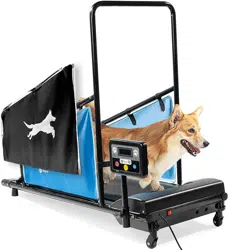Loading ...
Loading ...
Loading ...

Endurance Training Collection 25
24 PawRunner User Manual Lifepro
• Pets with arthritis or other joint or mobility issues may need a slow, short
warm up before exercise. A warm up could be a few minutes walking around
the yard, or a five-minute walk on the treadmill at the lowest speed.
• Pets with arthritis or other joint or mobility issues should avoid running on
the treadmill as this could cause pain and further joint issues.
• Small pets, such as cats and smaller dog breeds, are not well-suited for
jogging and running, and thus it is important to keep the speed low for
them.
• Do not exercise puppies until they are cleared for exercise by your
veterinarian.
• Never force your pet to get on the treadmill as this could create a negative
association for them.
• Use the treadmill in a well-ventilated room and avoid using in rooms that
are too warm to prevent heat exhaustion and heat stroke.
• Do not place the treadmill with the back of the running belt against a wall,
door, stairs, or any other obstruction. Ensure there is at least 7 feet of
clear space behind the treadmill.
• Never allow more than one pet to use the treadmill at a time.
• Take your pet out to so they can relieve themselves before exercise.
• Always wait at least 1 hour after meal to begin your pet’s workout.
PREVENTING OVER-EXERCISE AND OVEREXERTION
It is very important to closely supervise your pet during exercise to
prevent injury and overexertion. Some breeds have a tendency to overexert
themselves; however, any pet could become overexerted if exercised
incorrectly or if allowed to exercise too intensely or for too long.
WARNING: Overexertion, excessive or incorrect exercise can cause
sore paws or muscles, joint pain or injury, heat exhaustion or heat stroke,
and even death.
Signs* your pet needs to stop exercising and rest:
• Your pet is panting heavily (during or after exercise) and seems unable to
catch its breath.
• Your pet slows down or stops exercising altogether.
• Your pet begins to limp.
• Your pet seems unusually tired, or sleeps or lays around more than
normal after exercise.
• Your pet seems stiff or sore after exercise. This may not appear until
hours or even days after exercise, so it’s important to keep careful notes
about how long each session lasts and how your pet seems in the days
after exercise. See
EXERCISE DOCUMENTATION on page 27.
• Your pet’s gums are an unusual color, including purple/blue, gray, or
bright red, which could indicate dehydration.
• Your pet seems extremely thirsty.
• Your pet seems confused or can’t focus.
• Your pet shows signs of heat exhaustion or heat stroke, symptoms of
which include:
• Dehydration: a dry nose, sunken eyes, excessive tiredness or panting,
and unusual coloring of the gums can indicate dehydration.
• Fever: a hot, dry nose (rather than wet and cool) can indicate fever.
• Excessive drooling: lots of drool, or drool that is thicker or sticker than
normal.
• Rapid pulse.
• Shivering or muscle tremors.
• Lethargy or weakness.
• Lack of urine.
• Dizziness.
• Vomiting or diarrhea.
WARNING: If you think your pet may be experiencing heat exhaustion
or heat stroke, get them to a cool location and contact your veterinarian
or an emergency veterinary clinic right away.
NOTE: The above signs and symptoms of overexertion, heat exhaustion, and
heat stroke are primarily seen in dogs. Consult your veterinarian for specific
signs and symptoms of overexertion and heat exhaustion in cats, ferrets,
and other pets.
PET EXERCISE SAFETY
Loading ...
Loading ...
Loading ...
